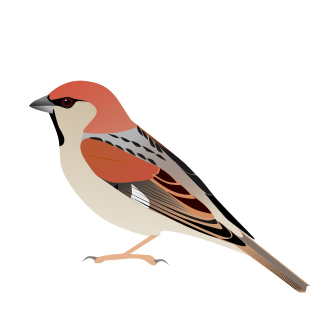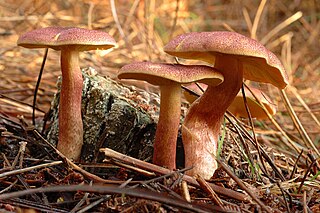Related Research Articles

The streaked xenops is a passerine bird which breeds in the tropical New World from Costa Rica and Trinidad south to Bolivia and northern Argentina. Like the closely related true woodcreepers, it is a member of the South American bird family Furnariidae.

The russet sparrow, also called the cinnamon or cinnamon tree sparrow, is a passerine bird of the sparrow family Passeridae. A chunky little seed-eating bird with a thick bill, it has a body length of 14 to 15 cm (5.5–5.9 in). Its plumage is mainly warm rufous above and grey below. It exhibits sexual dimorphism, with the plumage of both sexes patterned similarly to that of the corresponding sex of house sparrow. Its vocalisations are sweet and musical chirps, which when strung together form a song.

The Somali sparrow is a species of bird in the family Passeridae found in Somaliland, Djibouti, Ethiopia and Kenya.

Tricholomopsis is a genus of fungi closely related to the large genus Tricholoma. Its best known member and type species is Tricholomopsis rutilans. The name means appearing like Tricholoma. The genus has a widespread distribution, and contains about 30 species. Tricholomopsis was described in 1939 by American mycologist Rolf Singer.

Tricholomopsis rutilans, known by the unusual but apt common name of Plums and Custard or, less commonly Red-haired agaric, is a species of gilled mushroom found across Europe and North America.
The shining thicket rat is a species of rodent in the family Muridae.

The ruddy spinetail is a species of bird in the family Furnariidae. It is found in Bolivia, Brazil, Colombia, Ecuador, French Guiana, Guyana, Peru, Suriname, and Venezuela. Its natural habitat is subtropical or tropical moist lowland forests.

Whitfieldia is a genus of plants in the family Acanthaceae with about 14 species in tropical Africa.
A Crown of the Rose is an extremely rare gold coin of the Kingdom of England introduced in 1526 during the reign of Henry VIII, in an attempt to compete with the French écu au soleil. The coin was not a success and just a few months later it was replaced by the Crown of the Double-Rose.

Nembrotha purpureolineata is a species of colourful sea slug, a dorid nudibranch, a marine gastropod mollusc in the family Polyceridae. Nembrotha rutilans, classified as a separate species until 2008, has now been reclassified as Nembrotha purpureolineata.

Hedychrum rutilans is a species of cuckoo wasps. The species occurs primarily in Austria, Italy, Bulgaria, Greece, France, Poland, Portugal, Spain, Switzerland and in North Africa. The head and thorax are metallic green with red spots, while the abdomen is red. The color is more green and partially golden in the male and more extensively golden-red in the female. The body is somewhat hairy.

Carabus rutilans is a species of ground beetle in the Carabinae subfamily that can be found in Andorra, France, and Spain.
Betta rutilans is a species of gourami endemic to Indonesia. Their habitat is blackwater streams and peat swamp forests with very little sunlight. Their name rutilans is Latin for "reddish", "grow red", or "being red".

Hapalopilus rutilans is a species of polypore fungus in the family Polyporaceae. Officially described in 1821, it was transferred to its current genus Hapalopilus six decades later. It is commonly known as the tender nesting polypore, purple dye polypore, or the cinnamon bracket. This widely distributed species is found on five continents. It grows on the fallen or standing dead wood of deciduous trees, in which it fruits singly, in groups, fused, or in overlapping clusters. Fruit bodies are in the form of kidney-shaped to semicircular, cinnamon-orange-brown brackets. The underside of the fruit body features a yellowish to brownish pore surface with tiny angular pores, from which spores are released.
Celaenorrhinus rutilans, the large sprite, is a butterfly in the family Hesperiidae. It is found in Guinea, Sierra Leone, Ivory Coast, Ghana, Nigeria, Cameroon, Bioko, Gabon, the Republic of the Congo, the Central African Republic and the Democratic Republic of the Congo. The habitat consists of forests.
Sagana rutilans is a species of spiders in the family Liocranidae. It was first described in 1875 by Thorell. As of 2020, it was the only species in the genus Sagana. It is found from Europe to Georgia. The genus name SaganaThorell, 1875 is a junior homonym of the moth genus SaganaWalker, 1855, so the combination Sagana rutilans is unavailable, but as of October 2020 was still used in the World Spider Catalog.
Billaea rutilans is a species of bristle fly in the family Tachinidae.

Afarsia is a Palearctic genus of butterflies in the family Lycaenidae.It has been synonymized with Albulina by some authors, but studies on the molecular phylogenetics of Polyommatini have led to its treatment as an independent genus, which appears as the sister group of the genus Kretania sensu lato, with weak support.
The rusty-shouldered ctenotus is a species of skink found in Western Australia.

Aphareus rutilans, the rusty jobfish, ironjaw snapper, red smalltooth job, silvermouth or small tooth jobfish, is a species of marine ray-finned fish, a snapper belonging to the family Lutjanidae. It is found in the Indo-Pacific region.
References
- ↑ BioLib.cz - Mauesia rutilans. Retrieved on 8 September 2014.